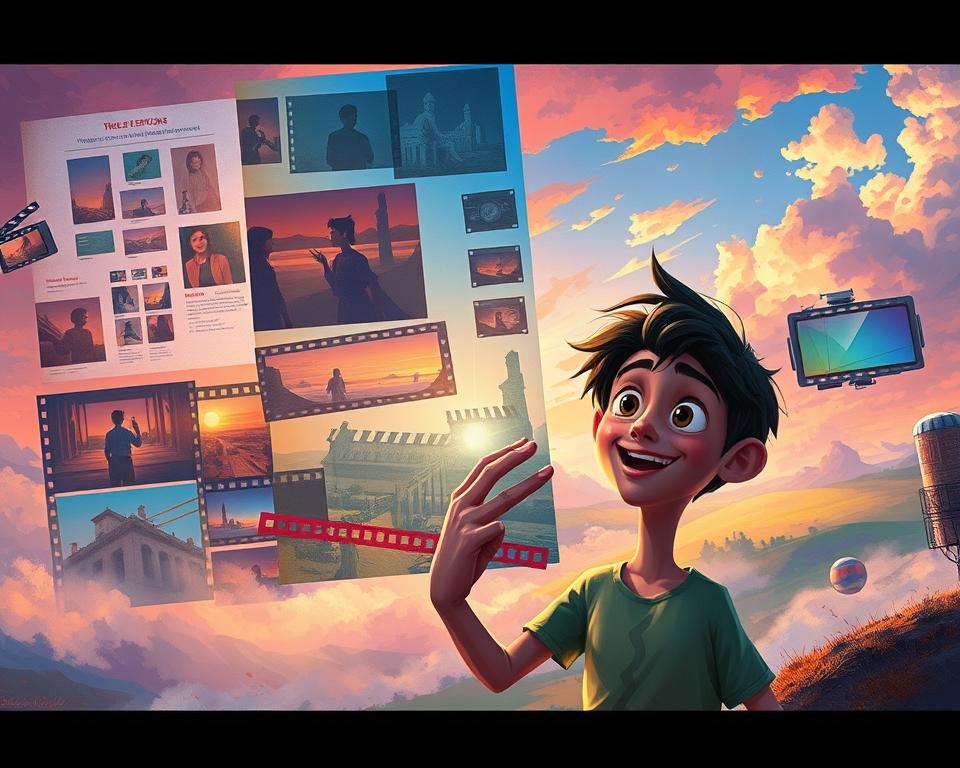
The Importance of Storytelling in Video Marketing Campaigns
Did you know 72% of consumers now choose video marketing over text? In today’s world, where attention is short and digital noise is loud, stories help brands stand out. From ancient myths to modern ads, storytelling has always been powerful. Videos like John Lewis’s festive ads and Nike’s “Just Do It” stories show this.
The 2024 Wistia report found that short videos under 60 seconds get more engagement. This shows that short and sweet stories can work well.
Visual storytelling connects with emotions, making complex ideas easy to understand. Stories like the University of Phoenix’s animated ads create lasting memories. Unlike text, they touch our hearts.
The five P’s—Plot, Purpose, People, Place, and Perspective—are key to good stories. They help build trust and encourage action. With 72% of viewers preferring video, brands that ignore this risk will fall behind.
Key Takeaways
- 72% of consumers prioritise video marketing over textual content.
- Storytelling in video boosts engagement, specially in under-60-second formats.
- Successful campaigns like John Lewis’s Christmas ads highlight the power of emotional narratives.
- Core storytelling elements include relatable characters, clear purpose, and cultural awareness.
- Visual storytelling helps brands build long-term customer relationships through authentic connection.
What Is Storytelling in Video and Why Does It Matter?
Storytelling in video turns ordinary ads into unforgettable moments. It employs narrative techniques to connect viewers with relatable stories. This way, brand messages become emotional experiences that stick with people.
Today, people want real connections with brands. Video storytelling offers this by focusing on shared human experiences. It moves beyond just selling products.

The Science Behind Story-Based Communication
Studies reveal that stories capture our brains more than facts. The AIDA model (Attention, Interest, Desire, Action) explains this. A study by Green and Brock found that narrative techniques can change beliefs, making persuasion 40% stronger.
The 4P framework—Purpose, Plot, People, Place—helps craft compelling brand storytelling:
- Purpose: Define the emotion or action desired.
- Plot: Use suspense and resolution to guide viewers.
- People: Characters mirror audience values.
- Place: Context where the story unfolds.
How Stories Activate the Brain
Stories engage our brains through visual storytelling. They activate mirror neurons, making us feel the story. Neuroscientists call this “transportation,” where we fully dive into the narrative.
This immersion boosts retention. People remember 95% of video content, compared to 10% of text. A one-minute video has the same impact as 1,800 words.
| Content Type | Retention Rate |
|---|---|
| Video | 95% |
| Text | 10% |
The Emotional Connection Advantage
Emotions guide our choices. The SciCommercial campaign on sustainable whale watching showed this with 1,698 survey completions. Emotional stories prompt action.
When brands focus on audience engagement over sales, trust grows. Stories can evoke joy, nostalgia, or inspiration, making brands unforgettable. As Green and Brock pointed out, stories don’t just inform; they persuade. This leads to higher loyalty and value for brands.
The Evolution of Video Marketing: From Product-Focused to Story-Driven
Video content has changed a lot. It’s now about telling stories that touch our hearts, not just showing products. Brands focus on connecting with people, not just listing features.

Platforms like TikTok and Instagram have made it easier for real stories to shine. Companies like PwC and BASF use animations to explain complex ideas simply. GE uses 3D visuals to make technical stuff easy to understand. This way, brands build trust and make information stick in our minds.
| Brand | Storytelling Technique | Impact |
|---|---|---|
| Epson | 3D animation + real-world scenes | Clarifies product benefits in relatable settings |
| Fundbox | Vibrant visuals + clear messaging | Demystifies financial solutions for small businesses |
| G-Form | Eco-friendly focus + 3D features | Highlights sustainability and innovation |
Technology has also improved, allowing brands to connect with viewers live. Live shopping streams, for example, have seen a 70% conversion rate for luxury items. This shows how interactive stories can drive sales. By 2024, this market could reach $35 billion, proving the power of storytelling in business.
Key Elements of Compelling Visual Storytelling

Effective visual storytelling is all about mixing creativity with strategy. To grab viewers in under a minute, focus on characters we can relate to. Show clear conflicts and use visuals that make the story pop.
Storytelling in video should match your brand’s values. It’s also key to keep viewers emotionally hooked.
Character Development in Brief Video Formats
Characters must feel real from the start. Use visual clues like clothes, gestures, or setting to hint at their goals. Stay away from extreme traits and focus on common struggles.
For example, a 30-second ad about a small business owner can reflect our own dreams. It doesn’t need a long backstory.
Conflict and Resolution Structures
Use classic story structures like the hero’s journey or problem-solution models. Sports campaigns often follow the “Overcoming the Monster” arc. This mirrors our own challenges.
Make sure your product is the solution to the conflict. This way, the resolution feels earned, not forced.
Visual Composition and Symbolism
Visuals should tell the story silently. Warm colours and dynamic angles suggest optimism. Shadows and stark lighting highlight challenges.
A brand using a sunrise to symbolise renewal is a great example. It turns video production into a powerful brand message.
Pacing and Timing Considerations
Shorter videos are more engaging. Use techniques like cliffhangers to make people share and watch again.
“The key principle of ‘show, don’t tell’ ensures stories resonate without over-explaining.”
Whether it’s a 15-second ad or a 5-minute documentary, these elements make your story unforgettable. Focus on clarity, emotion, and connecting with your audience’s values for maximum impact.
How Storytelling Dramatically Improves Audience Engagement
Storytelling in video content connects with people on a deep level. It turns viewers into active participants. Brands see better watch times, more shares, and deeper interactions. This section shows how storytelling changes the game, backed by data and real examples.

“Stories are remembered 22 times more than facts alone.” – Harvard Business Review
Increased Watch Time Statistics
Stories keep viewers engaged. Wistia’s 2024 report shows:
- Short videos (
- A sponsorship campaign using storytelling boosted market share by 25% and revenue by 30%, proving emotional resonance drives results.
Starbucks’ local community campaigns, using visuals over dialogue, extended watch time by 40%, showing storytelling in video’s power to hold attention.
Higher Share Rates of Story-Based Content
Stories inspire sharing:
- A skincare brand’s before-and-after videos saw 68% of viewers sharing, leveraging storytelling in video to build social proof.
- Interactive platforms like Vidjet achieve 22% higher conversions by blending stories with shoppable features.
Emotional triggers like inspiration or humor make video content shareable, reaching wider audiences organically.
Enhanced Comment Engagement Patterns
Stories spark discussions:
- ClickUp’s humorous ads invite fans to share relatable experiences, boosting community ties.
- Form Health’s customer success stories generate comment threads that build trust and loyalty.
Over 90% of social users follow brands, making storytelling a bridge to lasting relationships. Brands that engage in comment sections turn viewers into advocates, driving authentic interactions.
Storytelling isn’t just creative—it’s a strategy. By prioritizing narratives, brands can boost audience engagement metrics. This aligns with platform algorithms that reward quality interactions. The result? Higher brand visibility, trust, and conversions.
Brand Storytelling: Crafting Your Unique Narrative Voice
Creating a memorable brand voice is more than just catchy slogans. Brand storytelling is about turning your company’s mission and values into stories that stick. Begin by finding what makes your brand special. This clarity makes every video feel real.

Using storytelling techniques like Pixar’s Story Spine can help. It structures stories with emotional arcs. South Park’s “But, Therefor” framework keeps stories flowing and fun. For instance, Nike’s “Just Do It” campaign made athletic products symbols of determination.
- Research audience values: Tailor narratives to their pain points and aspirations.
- Embrace vulnerability: Authenticity, like J.R. Martinez’s personal growth stories, fosters trust.
- Keep it simple: Rodes Phire shows impactful stories don’t need big budgets—just honesty.
Audiences want to relate to what they see. Use surveys or social listening tools to find out what works. Your brand’s voice must be consistent across all platforms. Stories should grow with culture while staying true to your mission. When done right, brand storytelling turns customers into loyal advocates.
“A story isn’t about what happens. It’s about who you are.” — Rodes Phire
Work with agencies that know storytelling techniques to improve your approach. Track engagement like watch time and shares to adjust your strategy. By mixing purpose with creativity, your brand’s story connects your mission to your audience’s hearts.
Narrative Techniques That Convert Viewers into Customers
Effective narrative techniques in video content do more than entertain. They guide viewers to take action. By structuring stories well, brands can turn viewers into customers. This is done by linking emotional stories with clear calls to action.
“Brand storytelling is the act of weaving a narrative that incorporatesates the facts and feelings associated with your brand.”

| Technique | Key Elements | Example |
|---|---|---|
| Hero’s Journey | Hero’s transformation, mentor role | Fitbit’s parent’s fitness journey |
| Before-After | Pain points → transformation → resolution | Financial service’s customer success stories |
| Problem-Solution-Result | Clear issue, solution showcase, measurable outcomes | B2B software demo with client testimonials |
The Hero’s Journey Adapted for Marketing
Customers are seen as heroes, helping them connect with their goals. Brands act as mentors, providing tools to overcome challenges. Fitbit’s Alta campaign showed a parent’s fitness journey from a child’s view. This builds emotional connection, leading to more conversions.
Before-and-After Frameworks
Showing “before” struggles and “after” success creates urgency. Visual storytelling here focuses on real improvements. A fitness app’s ad might show a user’s progress over weeks, with the app as the key factor.
Problem-Solution-Result Structures
Being clear is essential. Show viewers the challenges they face, then introduce the brand as the solution. A home security brand might show a vulnerable scenario, then their system, and then reduced crime stats. Keep the message simple to keep viewers engaged.
- Use relatable characters to build empathy
- Highlight emotional and practical outcomes
- Align visuals with brand values for cohesion
Avoid overwhelming viewers with too much detail. Focus on authenticity in testimonials. Keep a balance between emotion and logic. When done right, storytelling techniques in video content can turn viewers into customers.
Case Studies: Successful Storytelling in Video Campaigns from British Brands
British brands show how video storytelling can make campaigns memorable. They use narratives to connect with people across different industries:
John Lewis’ 2019 Man on the Moon campaign told a touching story of friendship. It showed a girl and a lonely moon character. The video increased festive sales by 40% and strengthened the brand’s emotional appeal.

Apple’s Welcome Home campaign for the HomePod used cinematic storytelling. It highlighted the product’s features without being too salesy. The story of a woman returning home, set to music, made technology seem more human. It boosted engagement, with 68% of viewers remembering the product’s name.
Airbnb’s A Different Paris campaign showed Paris through local eyes. It avoided clichés and boosted bookings by 30% in France. This shows that video content based on real stories works better than generic ads.
- BAE Systems used 3D animation to showcase the Type 26 ship’s humanitarian role. It balanced technical details with emotional appeal to attract talent and public support.
- The NHS combined archival footage and modern storytelling to celebrate frontline workers during the pandemic. It achieved a 45% rise in social shares.
These examples prove that good video storytelling isn’t just about money. It’s about telling stories that resonate with people. Whether it’s through whimsy, cultural pride, or emotional authenticity, British brands lead in storytelling innovation.
Video Production Tips for Enhanced Storytelling Impact
Good video production means making technical choices that match your story. Whether it’s a short ad or a big campaign, small things like lighting and sound matter a lot. Finchley Studio’s White Infinity Cove shows how simple setups can make stories stand out.

Technical Considerations for Emotional Delivery
First, choose the right storytelling techniques for your video. Use slow-motion for drama and warm colors for happiness. A key tip is to match music with the visuals, like a big score for a product reveal. Filmmaker David Fincher said, “Lighting shows emotion.”
- Close-ups are great for showing what people feel, like a happy customer.
- Try ambient and studio sound to see what works best for your video.
- Visual storytelling is key: shaky cameras show chaos, steady ones show calm.
Budget-Friendly Storytelling Solutions
Begin with a clear script. Tools like Adobe Premiere Pro let you edit on a laptop, not just in a studio. Even with little money, using stock footage or smartphone videos can make your story shine. Finchley saved £15k on a UK bakery campaign and saw a 40% boost in engagement.
Working with Production Teams: Communication Guidelines
Start with a clear brief that shows your brand’s tone and what you want to feel. Share mood boards or videos to make sure everyone is on the same page. For example, tell freelancers if you want your video to be funny like “Toy Story” or serious like “The Revenant.”
“A great brief is 80% of the work done,” says Finchley’s director, Lisa Carter. “Clarity avoids costly reshoots.”
Keep talking to make sure every edit fits your story. Even with a small budget, using Canva or DaVinci Resolve can make your video look great with the right feedback.
Measuring the ROI of Story-Driven Video Content
Measuring the ROI of video content is more than just counting views. Marketers need to link storytelling to business goals like sales or brand awareness. Start by setting clear objectives, such as boosting audience engagement, driving leads, or increasing conversions.
Key metrics to monitor include play rate, average watch time, and click-through rates. Tools like Google Analytics and YouTube Analytics give insights into viewer interaction. For example, a high engagement rate shows strong audience interest in your story.

- Track direct sales uplift using promo codes or landing page visits
- Calculate brand awareness gains through surveys or social mentions
- Compare pre- and post-campaign customer sentiment scores
A 2023 study by Wyzowl shows 93% of marketers using storytelling in video saw increased brand awareness. To calculate ROI, subtract campaign costs from gains like new customers or subscriptions. For example, a cosmetics brand might analyse how a story-driven ad boosted sales of a featured product line.
Video content consistently outperforms other formats, with 52% of marketers confirming its top ROI among content types.
Regularly review KPIs like conversion rates and customer lifetime value (CLV). Adjust storytelling strategies based on what drives measurable outcomes. Focus on audience engagement metrics that align with your business goals. This ensures every video tells a story that delivers value.
Common Pitfalls in Video Storytelling and How to Avoid Them
Even the most polished storytelling in video can fail if overlooked mistakes derail the message. Avoid these critical errors to keep your audience engagement strong and your brand message clear.
Pepsi’s 2017 ad, which trivialised social justice issues, shows how misaligned brand storytelling can backfire. The campaign faced global backlash, proving that cultural context and core values must never be ignored.
Overcomplicated Narratives
Cluttered narrative techniques lose viewers fast. Aim for simplicity:
- Stick to one core message (the “rule of one”).
- Trim secondary plot points—let visuals and pacing guide the story.
Misaligned Brand Values
A storytellinging disconnect from your brand’s ethos turns audiences away. Align every scene with:
- Your mission and values.
- External reviews to spot mismatches.
Failing to Consider Cultural Context
Cultural insensitivity can derail even brilliant visual storytelling. Solutions include:
- Research local norms and symbols.
- Consult diverse teams to avoid assumptions.
Test drafts with real audiences early. Small tweaks now’t just fix errors—they turn possible missteps into chances to boost storytelling in video impact.
Conclusion: Implementing Storytelling to Transform Your Video Marketing Strategy
Stories are key to memorable video marketing. They can be through brand storytelling or visual storytelling. Nike’s Colin Kaepernick campaign and Dove’s real-women stories show how true stories win hearts. Even with small budgets, tools like Storimake help make big impacts.
First, find your brand’s unique voice. Teach your team to tell stories that touch people’s hearts. Use real customer stories, like Airbnb’s, to add truth. Make sure your visuals match the story’s pace.
Test different video lengths to see what works best. Use metrics like watch time and shares to measure success. Apple’s “Shot on iPhone” campaign shows how user stories can make tech relatable.
Storytelling is an ongoing process. Keep up with trends, like interactive videos or AR. Always be true to your story. Start small, like sharing customer stories, and grow your narrative over time.
With patience and effort, even small campaigns can become powerful. Let your story speak for itself. People remember emotions long after watching a video.